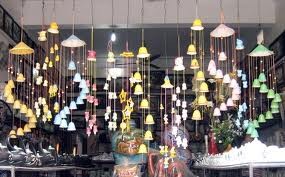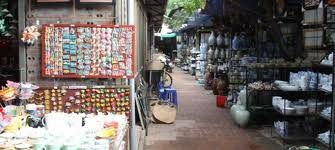(VOVworld) – Bat Trang on the outskirts of Hanoi is an ancient ceramic village dating from the 15th century. It has become a popular destination for both local and foreign tourists. Let’s find out more about this historic craft village via French journalist Yannick Falt.
Journalist Yannick Falt said he was very impressed with the romantic view and landscape of Bat Trang when he first visited it: “I love the tranquility here. It’s very peaceful and far different from the hustle and bustle of Hanoi.”
Anyone who comes to Bat Trang will quickly realize that this is a ceramic village for the various products everywhere. Though the shops look modest from the outside, inside visitors will be amazed with the variety and diversity of the ceramics displayed and for sale. The market in the village’s center is the focal point of this area. The clanging of wind chimes and chinaware makes the market environment vivid and lively. Yannick said Bat Trang products remind him of a suburb in his home country: “That shop over there displays many ceramic dogs which remind me of the Anzat region in France where local people place lots of ceramic dogs and cartoon characters in their gardens. When I saw these objects, I asked myself if they were brought from Bat Trang.”
 |
Yannick said he enjoys looking at and handling made-in-Bat Trang products, particularly tiny colorful decorative items like wind chimes, small animals or bracelets: “I see both raw and finished products here. I don’t know if these products will be sold in Hanoi, Vietnam or abroad because there are so many of them.”
Tung, a local shop owner said Bat Trang products have been shipped to many countries since the 1990s including Japan, the Republic of Korea, the US, and the EU. Many of the village’s products are now on display at prestigious museums in the world including the Royaus Museum in Belgium and the Guimet Museum in France. Tung said the villagers always try their best to produce high quality and creative products: “The glaze of our products is very shiny and imparts a feeling of softness. Our products are always heavier than those produced elsewhere as they have a higher composition of porcelain.”
 |
After the market, Yannick visited one of the biggest ceramic workshops in the village where he was introduced to modern ceramic production processes. Yannick said “This kiln was produced in Vietnam using German technology. After filling the kiln with raw materials, we turn on the gas-fueled fire, which is kept until the inside temperature reaches 1.200 degrees. It takes up to 30 hours to produce a batch of ceramic products, which still have to go through more steps for completion.”
Visiting Bat Trang ceramic village is quite an interesting experience for Yannick. Its tranquility, sophisticated products and villagers’ hospitality will forever remain in the minds of visitors like him./.